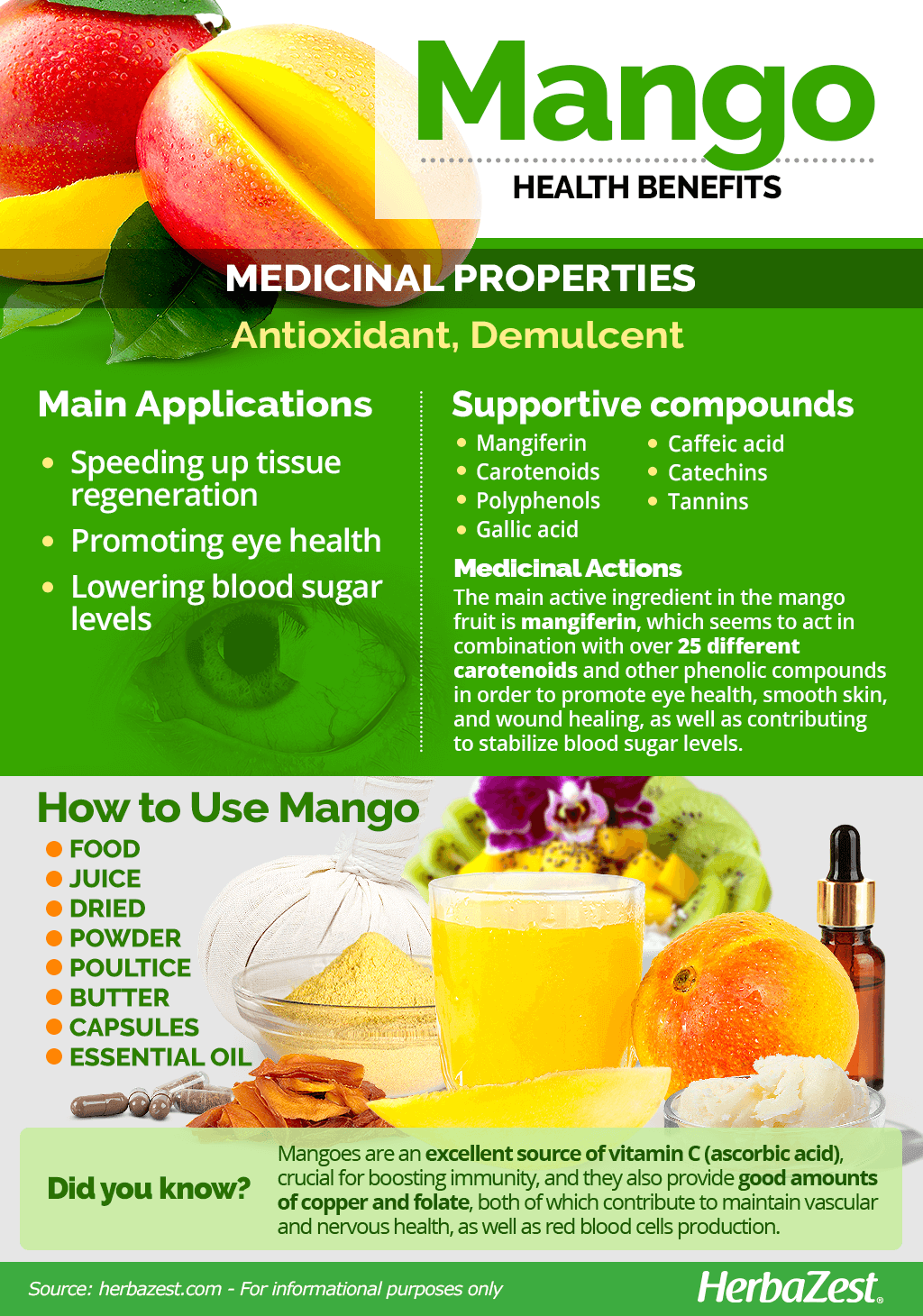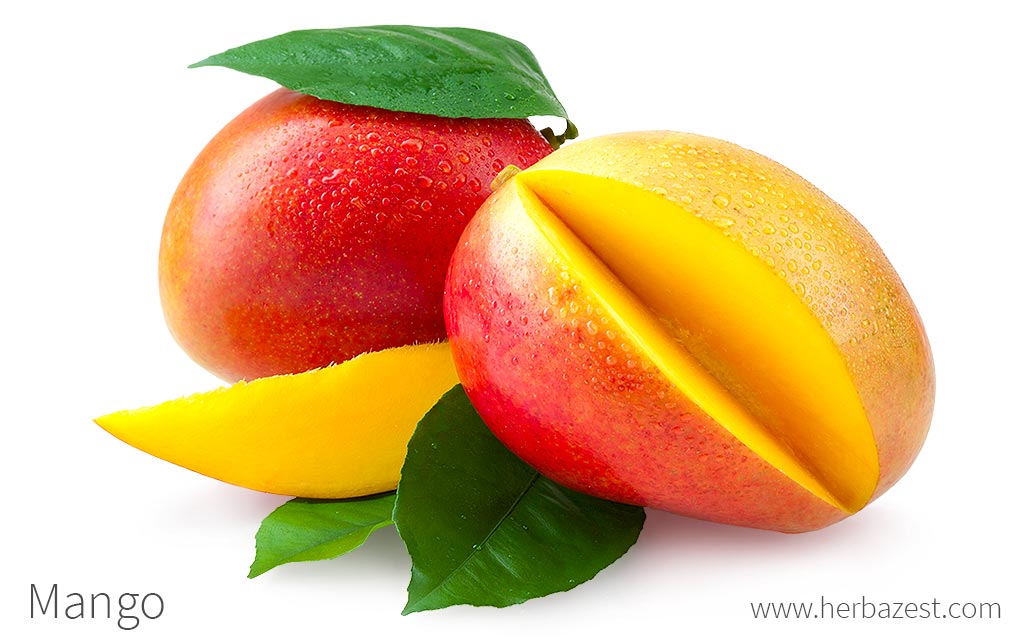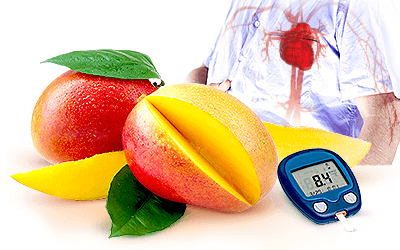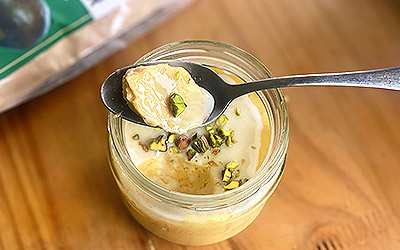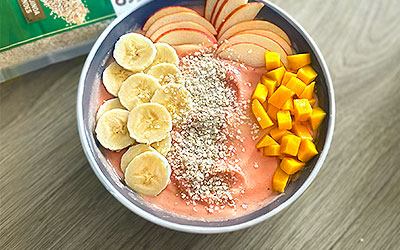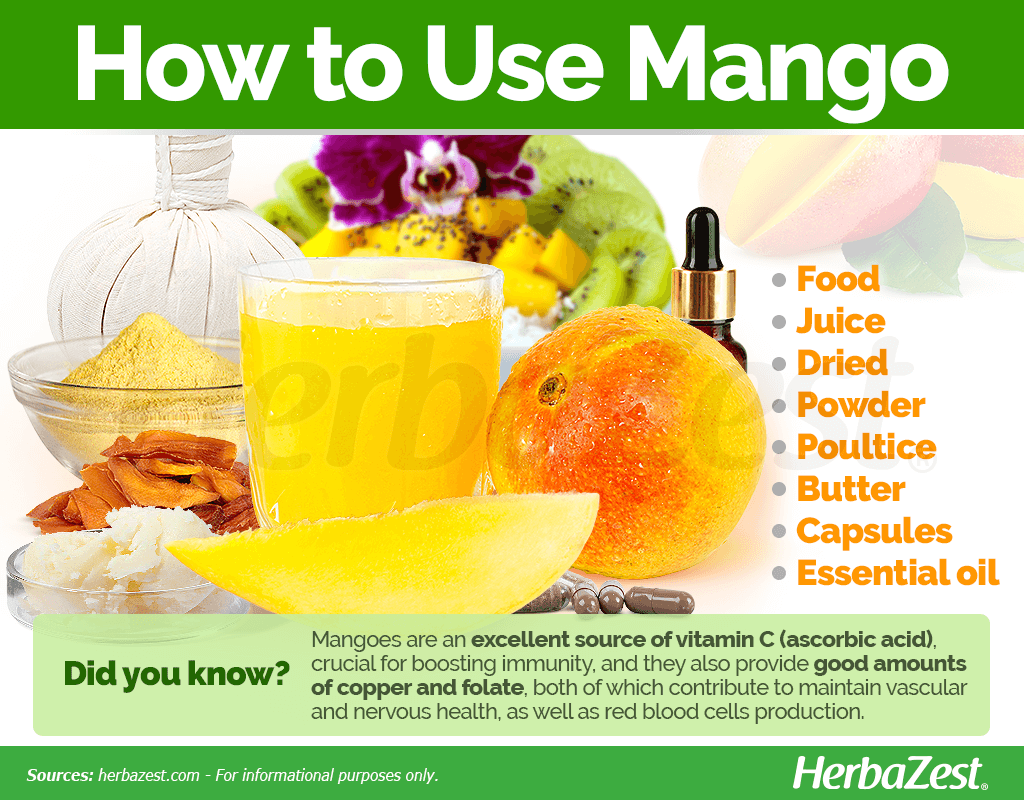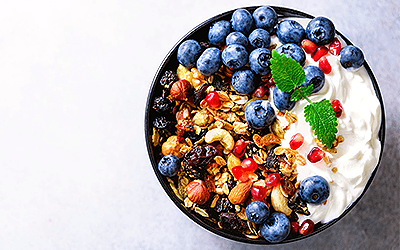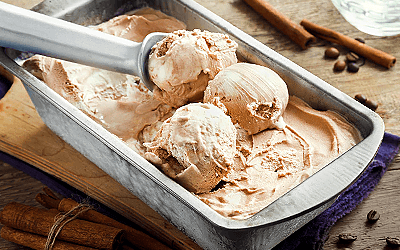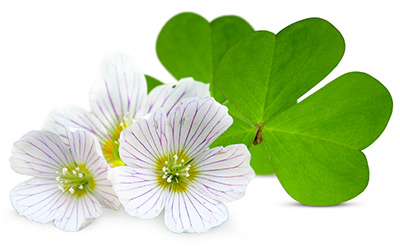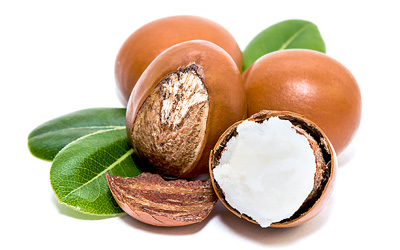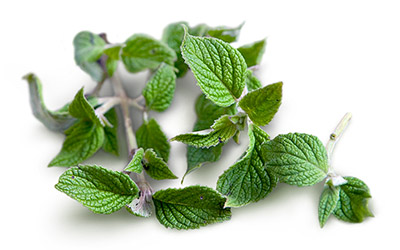Mango, a famous South Asian fruit, has been a popular addition to tropical, refreshing fruit platters for decades. It has had great cultural importance around the world for hundreds of years, and researchers believe it was first domesticated as a food crop in the subtropical regions of South Asia, approximately 6,000 years ago. Mangoes have become a standard food crop in northeastern India, and many people around the world consume them on a regular basis for their excellent nutritional value.
Mango Medicinal Properties
- Medicinal action Antioxidant, Demulcent
- Key constituents Mangiferin, carotenoids, polyphenols, gallic acid, caffeic acid, catechins, and tannins
- Ways to use Food, Juiced, Poultice, Powder, Dried
- Medicinal rating (3) Reasonably useful plant
- Safety ranking Safe
Health Benefits of Mango
Though research is ongoing, the properties of mango have been used traditionally for:
Speeding up tissue regeneration. Mango's antioxidant content improves the health of soft body tissues and promotes proper skin hydration, also aiding in the recovery of wounds.
Promoting eye health. Due to their high levels of carotenoids, mangoes help improve and mainta eye health, preventing vitamin A deficiency and age-related diseases, such as macular degeneration and cataracts.
Additionally, some studies suggest that mango benefits include lowering blood sugar levels, thus being effective in the complementary treatment and prevention of hyperglycemia and diabetes.
How It Works
Mangoes are best known for their nutritional value, but their therapeutic prowess lies in the rare phytocompounds present: the main active ingredient in the mango fruit is mangiferin, which has been shown to effectively reduce blood sugar levels, and it is presently undergoing extensive research.1 It seems to act in combination with over 25 different carotenoids, as well as polyphenols, gallic acid, caffeic acid, catechins, and tannins, in order to promote eye health and wound healing, as well as contribute to stabilizing blood sugar levels.2
Other important herbs with anti-inflammatory, regenerative properties are aloe, noni, and greater plantain, whereas apricot, carrot, and sweet potato are great for promoting eye health, and hypoglycemic properties can be found in fruits like figs, lucuma, and pepino.
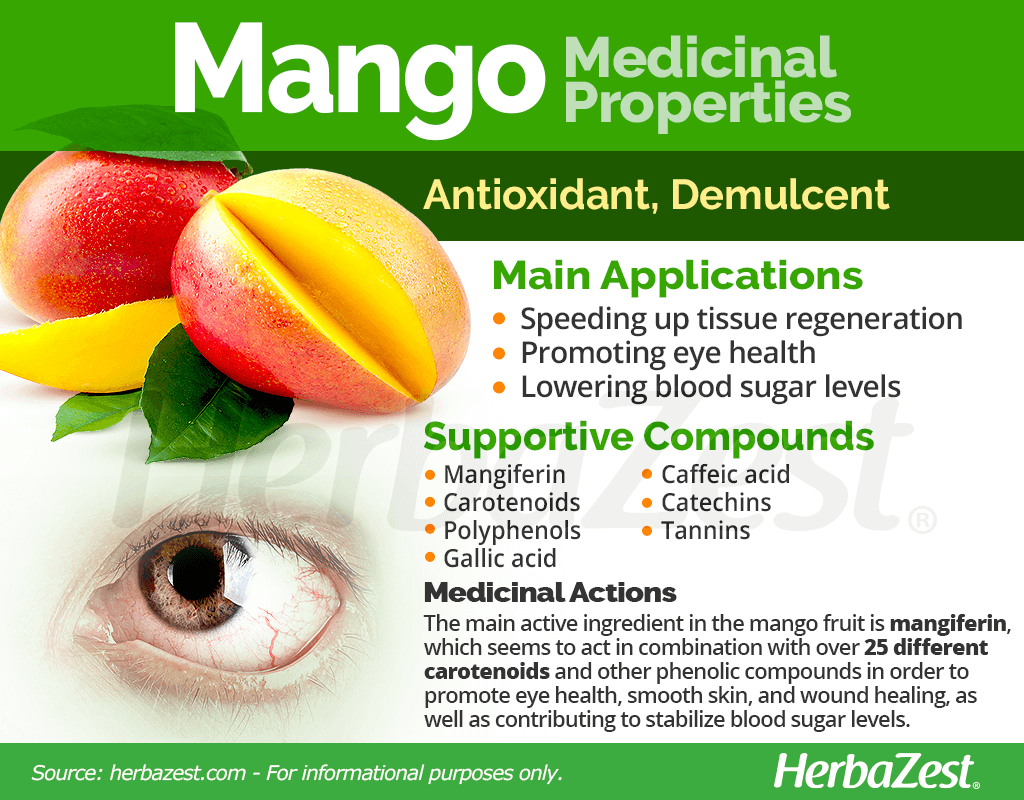
Mango Nutrition
Mangoes are an excellent source of vitamin C (ascorbic acid) which is crucial for the well-functioning of the immune system, as well as for proper plant-based iron absorption, strong bones, and heart health. In spite of its seemingly high level of sugar, the mango fruit provides adequate amounts of dietary fiber and carbohydrates, both necessary to help proper digestion and energy production, which increases satiety and reduces food cravings between meals.
Additionally, the presence of good amounts of copper and folate in mangoes contributes to maintain vascular and nervous health, as well as red blood cells production, whereas vitamins A (from carotenoids), B6 (pyridoxine), and E (alpha-tocopherol) support eye health, brain function, adrenal health, immunity, and cell metabolism.
The nutritional value of mangoes is rounded by less significant levels of many other compounds, including minerals such as potassium, manganese, and magnesium, as well as vitamins of the B-group and vitamin K.
100 grams of mango provide 60 calories, as well as 5% and 6% of the daily value for carbohydrates and dietary fiber, respectively.
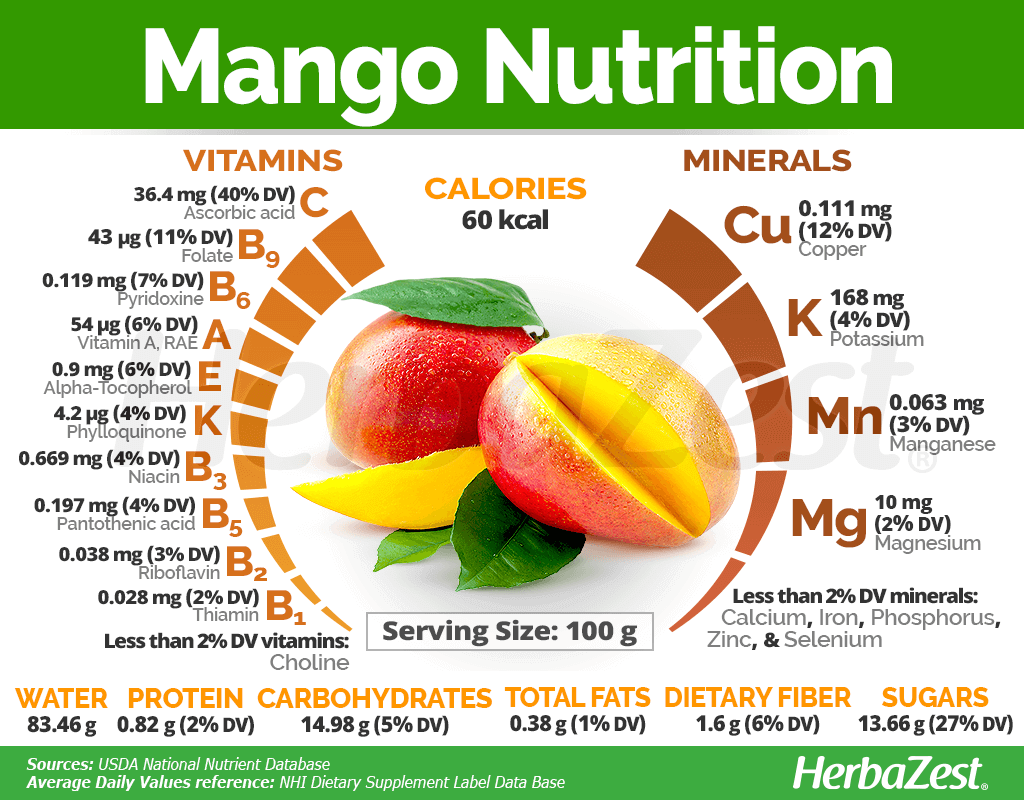
How to Consume Mango
- Edible parts Fruit
- Edible uses Beverage
- Taste Sweet
Natural Forms
Raw. The mango fruit is consumed mainly in its natural, fresh form in a variety of ways, including fruit saladas and many desserts.
Cooked. While cooking mango can reduce its water soluble vitamins, mainly vitamin C, it still can provide a good deal of nutrients. Mango fruit can be grilled as well as made into pies, jams, and chutney recipes.
Juice. Mango juice can be a source of energy and nutrition; however, it is recommended to use the whole pulp, including the dietary fiber, in order to slow down the sugar metabolism.
Dried. The dried pieces of mango ca be eaten as a snack, providing good nutrition and a good deal of dietary fiber, enough to satisfy a sweet tooth without causing blood sugar spikes.
Powder. Dried and pulverized mango makes a great antioxidant supplement that not only can improve overall health but also help treat funtional problems, such as constipation and irritable bowel sindrome (IBS).
Poultice. Crushed fresh mango can be applied topically in order to relieve skin inflammation.
Herbal Remedies & Supplements
Butter. Obtained from cold-pressing mango seeds, mango butter is sought for its soothing, regenerative properties. Its is tout as a great aid for skincare and hair growth.
Capsules. Mango leaf powder can be found as capsules and can be taken as a dietary supplement in order to control blood sugar levels and inflammatory conditions.
Essential oil. Mango essential oil is thought to have a relaxing effects when used in aromatherapy and massages. It soothes and exfoliates the skin.
Mangifera indica should not be confused with "African mango" (Irvingia gabonensis), since this is a completely different plant with a unique set of properties.
Growing
- Life cycle Perennial
- Harvested parts Fruit
- Light requirements Full sun
- Soil pH 6.1 – 6.5 (Slightly acidic)
- Growing habitat Subtropical regions
- Planting time Fall
A mango tree can be grown from seed , taking up to eight years to bear fruit. Given proper care and climate conditions, mangoes can be cultivated in a garden.
Growing Guidelines
The mango plant thrives best when grown in a frost-free, tropical climate, though some mango varieties are tolerant of lower temperatures provided they stay above 41°F (5°C).
In order for the fruit to develop as big as possible, it is best to plant the mango seeds on slight slopes that favor good drainage and in slightly acidic soils (pH of 6.0 - 7.0).
Early September is the ideal time for planting a mango tree. As much flesh as possible should be removed from the mango seeds, and they should be allowed to dry for two days.
Mango seeds should take up to 10 days to sprout initially. The seedlings should be planted in a position that is exposed to full sunlight.
Additional Information
- Other uses Dye, Fuel
Plant Biology
The mango is the fleshy stone fruit of a medium-sized evergreen tree. The fruit produced can be of different colors and sizes depending on the cultivar.
Classification
Mango, or Mangifera indica, is a member of the Anacardiaceae family, which contains flowering plants, including comercially relevant species, like cashews and pistachios. Mango is a member of the Mangifera genus, comprised of 69 species, most of which are canopy trees.
Subspecies and Cultivars of Mango
There are now over 1,000 mango varieties, which have been selectively bred to be more resistant to pests, grow better in certain climates, and produce juicier fruits. Around 20 of these are cultivated commercially in India, a country that boasts over 100 cultivars in all, including 'Alphonso,' 'Amrapali,' 'Bombay,' 'Banganapalli,' 'Bombay Green,' and 'Bangalora.' On the other side of the globe, the most frequently found mangoes in Western markets belong to the 'Tommy Atkins' cultivar.
Historical Information
The oldest remains of fossilized wild mango are over 25 million years old. Mangoes were initially propagated by monks in southern Asia around the 4th and 5th centuries BCE. By the 10th century CE, mangoes had been introduced to east Africa and the Middle East. By the 15th century, the mango as a food product had reached the rest of the world.
Popular Beliefs
Hindi and Tamil religious rituals frequently include mango fruits and branches. The branches are particularly popular for the purpose of decorating archways and houses during weddings and the Ganesh Chaturthi festival.
Economic Data
It is estimated that as of 2009, 35 million tons of mango have been produced worldwide annually. India remains mango's biggest producer, contributing over 16 million tons alone. In fact, mango is such a significant part of India's culture and economy that it has been named the national fruit. China, Thailand, Pakistan, and Mexico make up the rest of the top five producers. The top 10 mango-producing countries account for 80% of overall production.
Other Uses of Mango
Energy and shade
The bark of the mango tree can be used to make charcoal, and the tree is often planted to provide shade in sunny areas.
Paints and dyes
Mango extract is also used in the manufacturing of euxanthin, a yellow pigment widely used in oil paint.
Sources
- Government of India, National Fruit – National Symbols
- Government of South Africa, National Department of Agriculture: Cultivation of Mangoes
- International Journal of Food Sciences and Nutrition, Characterization of phenolic compounds in some Indian mango cultivars, 2004
- FAOSTAT, Mango production statistics
- USDA Nutrient Database, Nutrient Report 09176: Mangoes, raw
- Encyclopedia Britannica Online, Mango (fruit)
Footnotes:
- South African Journal of Botany. (2019). Mangiferin from Mangifera indica fruits reduces post-prandial glucose level by inhibiting α-glucosidase and α-amylase activity. Retrieved November 15, 2021, from: https://pubag.nal.usda.gov/catalog/6295219
- Food Chemistry. (2010). Antioxidant and antiproliferative activities of mango (Mangifera indica L.) flesh and peel. Retrieved November 15, 2021, from: https://pubag.nal.usda.gov/catalog/777998
